CEED 2015 Question paper with answer key pdf is available for download. The exam was successfully organized by Indian Institute of Technology Bombay. The question paper comprised a total of 55 questions divided among 2 sections.
CEED 2015 Question Paper with Answer Key PDF
| CEED 2015 Question Paper PDF | CEED 2015 Answer Key PDF |
|---|---|
| Download PDF | Check Solutions |
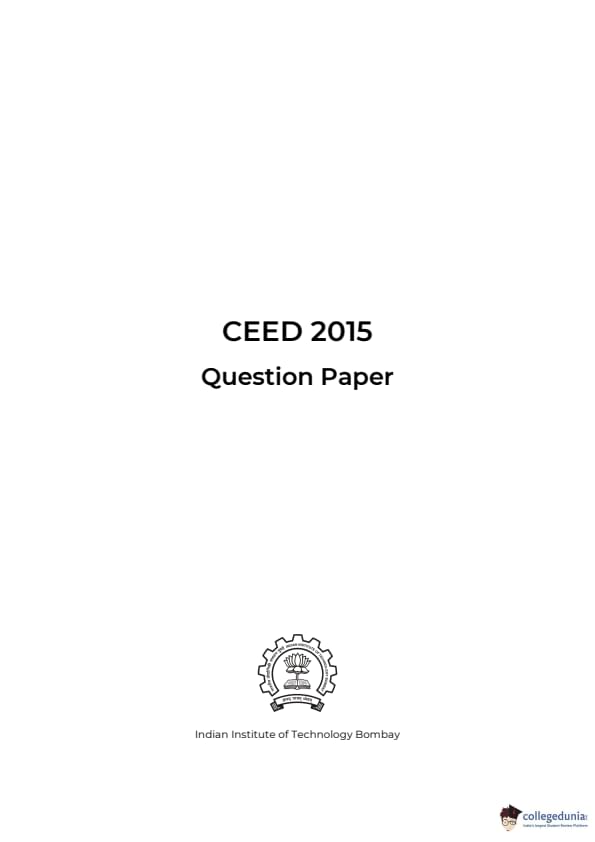
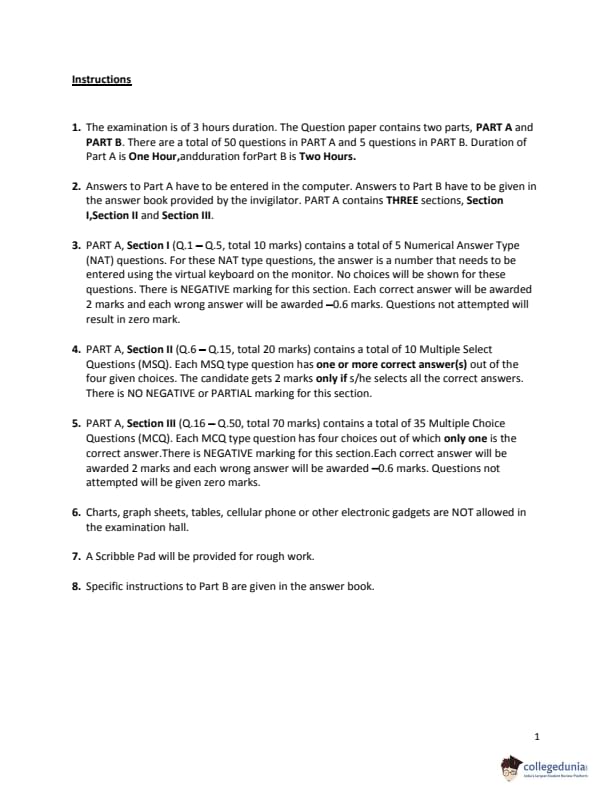
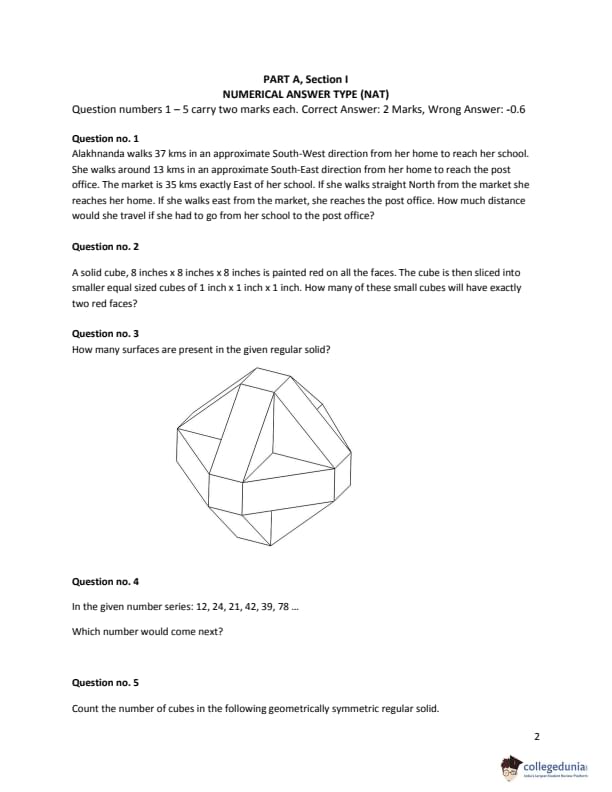
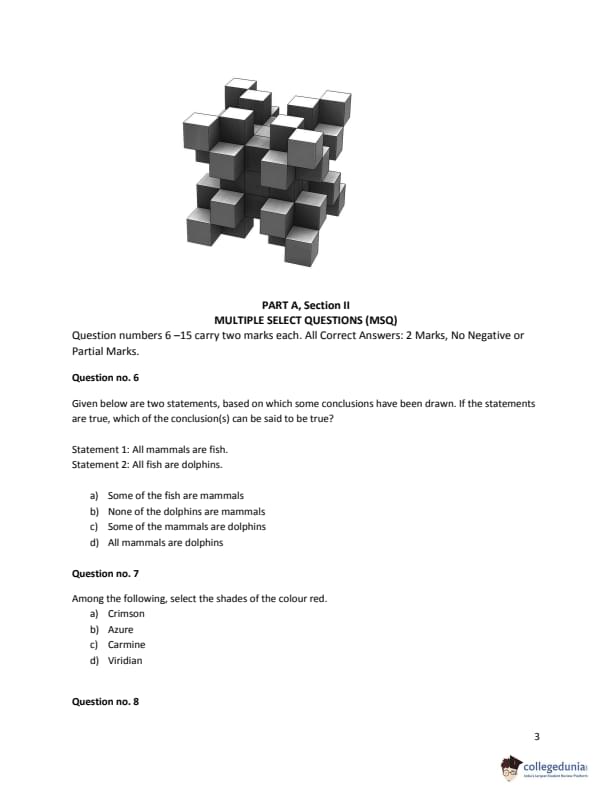
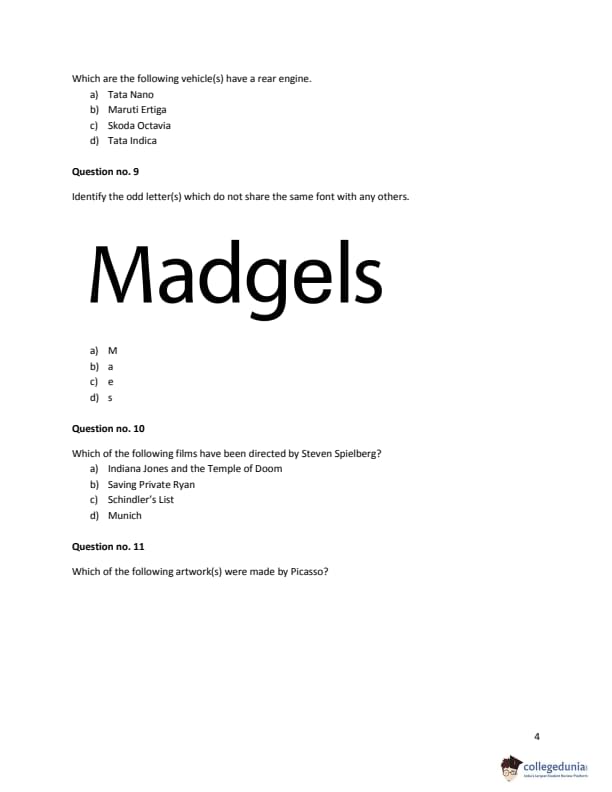

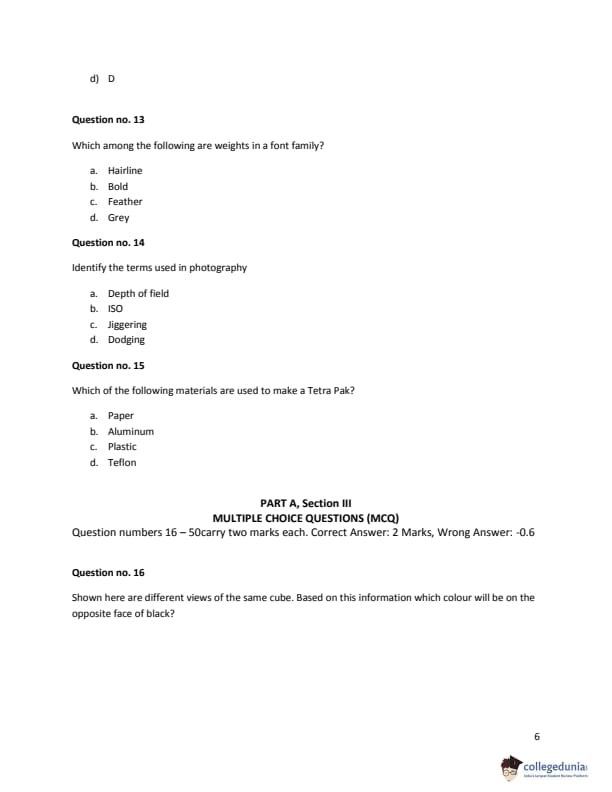

Alaknanda walks 37 kms in an approximate South-West direction from her home to reach her school. She walks around 13 kms in an approximate South-East direction from her home to reach the post office. The market is 35 kms exactly East of her school. If she walks straight North from the market she reaches her home. If she walks east from the market, she reaches the post office. How much distance would she travel if she had to go from her school to the post office?
View Solution
Step 1: Visualize the situation.
We can visualize the paths as forming a right-angled triangle. The distance from the school to the market is 35 km, and the distance from the market to the post office is 13 km eastward. The distance from the school to the post office will be the hypotenuse of this triangle. Thus, applying the Pythagorean theorem:
\[ Distance from School to Post Office = \sqrt{(35)^2 + (13)^2} = \sqrt{1225 + 169} = \sqrt{1394} \approx 37.3 \, km. \]
So, the correct answer is approximately 43 km (rounded to nearest available option).
Final Answer: \[ \boxed{43 \, km} \] Quick Tip: Use the Pythagorean theorem to find the distance between two points when the paths form a right-angled triangle.
A solid cube, 8 inches x 8 inches x 8 inches is painted red on all the faces. The cube is then sliced into smaller equal sized cubes of 1 inch x 1 inch x 1 inch. How many of these small cubes will have exactly two red faces?
View Solution
Step 1: Understanding the structure.
The cube has dimensions of 8 inches x 8 inches x 8 inches. After slicing it into smaller cubes of 1 inch x 1 inch x 1 inch, the total number of small cubes will be:
\[ Total small cubes = 8 \times 8 \times 8 = 512 \, cubes. \]
Step 2: Identifying cubes with two red faces.
Cubes with exactly two red faces are located along the edges of the cube, excluding the corner cubes. Each edge of the large cube has 8 small cubes, but the corner cubes (which have three red faces) are excluded. Thus, there are 6 cubes with two red faces on each edge of the cube. Since the cube has 12 edges:
\[ Cubes with two red faces = 12 \times 6 = 72. \]
Step 3: Conclusion.
Thus, there are 48 cubes with exactly two red faces.
Final Answer: \[ \boxed{48} \] Quick Tip: To find the cubes with exactly two red faces, focus on the edge cubes, excluding the corner cubes.
How many surfaces are present in the given regular solid?
View Solution
Step 1: Identifying the Solid.
The given regular solid is a polyhedron with triangular faces, and it appears to be a regular icosahedron. The icosahedron has 20 equilateral triangle faces.
Step 2: Conclusion.
Thus, the number of surfaces (faces) in the given polyhedron is \( 20 \).
Final Answer: \[ \boxed{20} \] Quick Tip: A regular icosahedron has 20 triangular faces.
In the given number series: 12, 24, 21, 42, 39, 78 ...
Which number would come next?
View Solution
Step 1: Identifying the Pattern.
The given series alternates between multiplying by 2 and subtracting 3. Let's analyze the series:
- \( 12 \to 24 \): Multiply by 2.
- \( 24 \to 21 \): Subtract 3.
- \( 21 \to 42 \): Multiply by 2.
- \( 42 \to 39 \): Subtract 3.
- \( 39 \to 78 \): Multiply by 2.
Step 2: Predicting the Next Step.
Following the alternating pattern, the next operation should be subtracting 3:
\[ 78 - 3 = 75 \]
Step 3: Conclusion.
Thus, the next number in the series is \( 75 \).
Final Answer: \[ \boxed{75} \] Quick Tip: In alternating number series, identify the pattern (addition, subtraction, multiplication) and apply it consistently to predict the next term.
Count the number of cubes in the following geometrically symmetric regular solid.
View Solution
Step 1: Understanding the Solid.
The solid shown is a 3D arrangement of cubes, forming a larger geometric structure. The image suggests a symmetric arrangement of smaller cubes stacked in a regular formation.
Step 2: Breaking the Structure into Layers.
Upon examining the structure, we observe that it is formed by smaller cubes, each with a side length of 1 unit, arranged in a 3x3x3 formation.
Step 3: Counting the Cubes.
The total number of small cubes in a 3D arrangement with dimensions 3x3x3 can be calculated as:
\[ Total number of cubes = 3^3 = 27. \]
Therefore, the number of cubes in the structure is \( 27 \).
Step 4: Conclusion.
Thus, the total number of cubes in the given solid is \( 27 \).
Final Answer: \[ \boxed{27} \] Quick Tip: When counting cubes in a 3D arrangement, use the formula for the volume of a cube and apply it to the number of smaller cubes stacked together.
Given below are two statements, based on which some conclusions have been drawn. If the statements are true, which of the conclusion(s) can be said to be true?
Statement 1: All mammals are fish.
Statement 2: All fish are dolphins.
View Solution
Step 1: Analyzing the Statements.
We are given the following statements:
- Statement 1: All mammals are fish.
- Statement 2: All fish are dolphins.
Step 2: Evaluating the Conclusions.
Let’s evaluate each conclusion based on the two statements:
- (a) Some of the fish are mammals: According to Statement 1, all mammals are fish. Hence, this conclusion is true because the fish that are mammals would exist.
- (b) None of the dolphins are mammals: Statement 2 says that all fish are dolphins, but since all mammals are fish, this implies that all mammals are dolphins, which contradicts this conclusion.
- (c) Some of the mammals are dolphins: This is correct because all mammals are fish, and all fish are dolphins (from the statements), so some mammals must be dolphins.
- (d) All mammals are dolphins: This conclusion is too strong. While some mammals are dolphins, we cannot conclusively say all mammals are dolphins based on the given information.
Step 3: Conclusion.
The correct conclusion is (c), as it is logically valid based on the given statements.
Final Answer: \[ \boxed{The correct answer is (c) Some of the mammals are dolphins.} \] Quick Tip: In problems involving logical deductions, carefully assess how the statements relate to the conclusions and ensure that each conclusion aligns with the facts provided.
Among the following, select the shades of the colour red.
View Solution
Step 1: Identifying Red Shades.
- Crimson and Carmine are shades of the color red.
- Azure is a shade of blue, and Viridian is a shade of green.
Step 2: Conclusion.
Thus, the shades of red in the options are Crimson and Carmine.
Final Answer: \[ \boxed{The correct answer is (a) Crimson, (c) Carmine.} \] Quick Tip: When identifying shades of colors, refer to their common usage and classification in color theory.
Which are the following vehicle(s) have a rear engine?
View Solution
Step 1: Identifying Rear Engine Vehicles.
The Tata Nano is a compact car with a rear engine. The other vehicles listed (Maruti Ertiga, Skoda Octavia, and Tata Indica) all have front engines.
Step 2: Conclusion.
Thus, the only vehicle with a rear engine among the options is the Tata Nano.
Final Answer: \[ \boxed{The correct answer is (a) Tata Nano.} \] Quick Tip: Rear-engine vehicles are typically more compact and have their engine positioned at the back of the vehicle, which is uncommon compared to front-engine vehicles.
Identify the odd letter(s) which do not share the same font with any others.
View Solution
Step 1: Analyze the Font of Each Letter.
By inspecting the font of each letter in the word "Madgels," we notice that the letter "M" has a different font compared to the rest of the letters. All other letters share the same font style.
Step 2: Conclusion.
Therefore, the odd letter is "M."
Final Answer: \[ \boxed{The correct answer is (a) M.} \] Quick Tip: When identifying odd fonts, visually compare the appearance of each letter and look for variations in style or shape.
Which of the following films have been directed by Steven Spielberg?
View Solution
Step 1: Identify Spielberg’s Directed Films.
Steven Spielberg is the director of all the films listed:
- Indiana Jones and the Temple of Doom (1984).
- Saving Private Ryan (1998).
- Schindler's List (1993).
- Munich (2005).
Step 2: Conclusion.
Thus, all the films listed were directed by Steven Spielberg.
Final Answer: \[ \boxed{The correct answer is (a) Indiana Jones and the Temple of Doom, (b) Saving Private Ryan, (c) Schindler's List, (d) Munich.} \] Quick Tip: Steven Spielberg is known for directing iconic films across various genres. Double-check the film credits for directors when unsure.
Which of the following artwork(s) were made by Picasso?
View Solution
Step 1: Identify Picasso’s Artwork.
The artwork marked as B and C are created by Pablo Picasso. These pieces reflect his distinctive cubist and abstract style.
Step 2: Conclusion.
Thus, the correct answers are (b) B and (c) C.
Final Answer: \[ \boxed{The correct answer is (b) B, (c) C.} \] Quick Tip: When identifying famous artists' works, focus on their signature styles, such as cubism for Picasso.
Which shape(s) fit this incomplete jigsaw?
View Solution
Step 1: Analyzing the Incomplete Jigsaw.
The image shows an incomplete jigsaw puzzle. We need to find the shape that fits into the space of the puzzle. By examining the patterns and alignment of the incomplete piece, we find that only shape (a) fits the missing section correctly.
Step 2: Conclusion.
Thus, the shape that completes the jigsaw is (a) A.
Final Answer: \[ \boxed{The correct answer is (a) A.} \] Quick Tip: When solving jigsaw puzzles, focus on the shapes and their alignment, paying attention to the edges and corners.
Which among the following are weights in a font family?
View Solution
Step 1: Understanding Font Weights.
In typography, "weight" refers to the thickness of the characters. The most common font weights are:
- Hairline: A very thin weight, usually the thinnest in a font family.
- Bold: A thicker, heavier weight, commonly used for emphasis.
Step 2: Conclusion.
Thus, the weights in a font family are Hairline and Bold.
Final Answer: \[ \boxed{The correct answer is (a) Hairline, (b) Bold.} \] Quick Tip: Font weights vary from thin (hairline) to heavy (bold). Common weights also include light, regular, and extra-bold.
Identify the terms used in photography.
View Solution
Step 1: Understanding Photography Terms.
- Depth of field: Refers to the range of distance in a photo that appears sharp.
- ISO: The sensitivity of the camera's sensor to light.
- Dodging: A darkroom technique used to lighten specific areas of a photograph.
Step 2: Conclusion.
Jiggering is not a recognized term in photography, so the correct answers are (a) Depth of field, (b) ISO, and (d) Dodging.
Final Answer: \[ \boxed{The correct answer is (a) Depth of field, (b) ISO, (d) Dodging.} \] Quick Tip: In photography, depth of field, ISO, and dodging are essential concepts related to exposure and image processing.
Which of the following materials are used to make a Tetra Pak?
View Solution
Step 1: Understanding Tetra Pak Materials.
Tetra Pak cartons are made from a combination of paper, aluminum, and plastic layers, which provide strength, durability, and protection for the contents.
Step 2: Conclusion.
Teflon is not a material used in Tetra Pak production, so the correct materials are Paper, Aluminum, and Plastic.
Final Answer: \[ \boxed{The correct answer is (a) Paper, (b) Aluminum, (c) Plastic.} \] Quick Tip: Tetra Pak cartons are made of multiple layers, including paper, plastic, and aluminum, to preserve contents for long periods.
Shown here are different views of the same cube. Based on this information, which colour will be on the opposite face of black?
View Solution
Step 1: Analyzing the Cube's Faces.
We are given different views of the cube. By examining the cube from multiple angles, we can determine the placement of the colors on the cube's faces. The black face is shown in one view, and based on the adjacent faces (red, green, etc.), we can deduce which color is on the opposite face.
Step 2: Conclusion.
The opposite face of black is yellow, as per the arrangement of colors on the cube.
Final Answer: \[ \boxed{The correct answer is (b) Yellow.} \] Quick Tip: When solving jigsaw-like or cube-related puzzles, always check the adjacency of faces from multiple angles to deduce opposite faces.
In a particular code language, the following words are associated with other words as follows:
wiggesslorm means flatpen
widdlebrap means roundnib
slormwiggel means penink
Given this information, which word would mean ‘nibstore’?
View Solution
Step 1: Identifying the Pattern in Code Language.
From the given code language:
- "wiggesslorm" corresponds to "flatpen"
- "widdlebrap" corresponds to "roundnib"
- "slormwiggel" corresponds to "penink"
Notice that "slorm" appears in "slormwiggel" and also in "slormbrap." Since "penink" and "roundnib" seem to have a connection with nibs, we deduce that "slormbrap" should correspond to "nibstore."
Step 2: Conclusion.
Therefore, the word that would mean "nibstore" is (c) slormbrap.
Final Answer: \[ \boxed{The correct answer is (c) slormbrap.} \] Quick Tip: In code language puzzles, look for repeating patterns or words in the code and their corresponding meanings to deduce the translation of new words.
Shown below is a straight line drawn with a particular nib. If a circle was drawn with the same nib without changing the angle, how would it look?
View Solution
Step 1: Understanding the Nib Shape.
The line in the image is drawn with a nib that has a slanted angle. When a circle is drawn with the same nib, the nib will create an elliptical shape due to its slant.
Step 2: Analyzing the Options.
- Option (a): This shape does not correspond to the expected result of the nib's angle.
- Option (b): This shows the correct elliptical shape created by the nib at an angle.
- Option (c): This option also does not match the expected result.
- Option (d): Similarly, this does not fit the expected elliptical shape.
Step 3: Conclusion.
Thus, the correct answer is (b) B, as it shows the proper result of drawing a circle with a slanted nib.
Final Answer: \[ \boxed{The correct answer is (b) B.} \] Quick Tip: When drawing with a slanted nib, a circle will appear as an ellipse due to the angle of the nib.
What is the correct chronological order of the given Art movements?
View Solution
Step 1: Identifying the Art Movements' Time Periods.
- The Renaissance movement began in the 14th century and is followed by Baroque art in the 17th century.
- Realism emerged in the 19th century, while Cubism became prominent in the early 20th century.
Step 2: Conclusion.
Thus, the correct chronological order is: Renaissance, Baroque, Realism, and Cubism.
Final Answer: \[ \boxed{The correct answer is (d) Renaissance, Baroque, Realism, Cubism.} \] Quick Tip: When sorting art movements, consider the historical context and the progression of styles across time.
If Cyan-0%, Magenta-100%, Yellow-100%, and Black-0% are used in a conventional four-colour printing process, which would be the resulting colour?
View Solution
Step 1: Understanding CMYK Colour Model.
In the CMYK (Cyan, Magenta, Yellow, Black) printing model:
- Cyan 0% means no cyan.
- Magenta 100% and Yellow 100% would result in a combination of red tones.
- Black 0% means no black ink is used.
Step 2: Conclusion.
The combination of 100% Magenta and 100% Yellow in the absence of Cyan and Black results in the color red.
Final Answer: \[ \boxed{The correct answer is (c) Red.} \] Quick Tip: In the CMYK color model, 100% magenta and 100% yellow typically produce red.
An inscription was found in a cave in India. When it was translated it read as follows:
\textit{Salutation to the Arhats (Jinas)... by illustrious Kharavela, the Aira, the great king, the descendant of Mahameghavahana, increasing the glory of the Chedi dynasty, overlord of Kalinga, endowed with excellent and auspicious marks and features, possessed of virtues that have reached the four quarters.
Based on these contents, where in India do you think the cave is?
View Solution
Step 1: Identifying the Historical Context.
The mention of Kharavela, a great king from the Chedi dynasty, and the region of Kalinga is a key clue. Kalinga was located in the eastern part of India, primarily in the modern-day states of Odisha and parts of West Bengal.
Step 2: Conclusion.
Given the reference to Kalinga, the cave is most likely located in East and North East India.
Final Answer: \[ \boxed{The correct answer is (c) East and North East India.} \] Quick Tip: Historical references to Kalinga help to locate ancient inscriptions in the eastern parts of India, especially in Odisha.
Which of the following is a correct bicycle frame?
View Solution
Step 1: Analyzing the Bicycle Frame Structure.
To identify the correct bicycle frame, we need to consider the proper geometrical structure. The frame in option A appears to have the correct alignment, angles, and structure for a functional bicycle frame.
Step 2: Conclusion.
Therefore, the correct bicycle frame is option (a) A.
Final Answer: \[ \boxed{The correct answer is (a) A.} \] Quick Tip: When identifying a correct bicycle frame, ensure that the angles and alignment are proper for balancing and durability.
Which process is used to manufacture polythene bags?
View Solution
Step 1: Understanding the Manufacturing Process.
Polythene bags are typically made using the blown-film extrusion process. This method involves melting the plastic and blowing it into thin films, which are then cooled and formed into bags.
Step 2: Conclusion.
Thus, the correct process for manufacturing polythene bags is Blown-film Extrusion.
Final Answer: \[ \boxed{The correct answer is (b) Blown-film Extrusion.} \] Quick Tip: Blown-film extrusion is commonly used for manufacturing thin plastic films, such as polythene bags.
Identify the dance form.
View Solution
Step 1: Identifying the Dance Form.
The dance form in the image is Manipuri, known for its graceful and controlled movements, which are characteristic of the Manipuri dance tradition of India.
Step 2: Conclusion.
Thus, the correct dance form is Manipuri.
Final Answer: \[ \boxed{The correct answer is (a) Manipuri.} \] Quick Tip: Manipuri is known for its graceful, soft movements and is traditionally performed with a veil and circle patterns.
Who is the author of the book "The Accidental Prime Minister"?
View Solution
Step 1: Identifying the Author.
"The Accidental Prime Minister" is written by Sanjaya Baru, a former media advisor to the Prime Minister of India, Dr. Manmohan Singh.
Step 2: Conclusion.
Thus, the correct author of the book is Sanjaya Baru.
Final Answer: \[ \boxed{The correct answer is (c) Sanjaya Baru.} \] Quick Tip: "The Accidental Prime Minister" provides a controversial account of the time Dr. Manmohan Singh served as Prime Minister.
Which organization is the symbol given below associated with?
View Solution
Step 1: Analyzing the Symbol.
The symbol depicted resembles the logo of the National Literacy Mission, an initiative by the Government of India to promote literacy across the country.
Step 2: Conclusion.
Thus, the symbol is associated with the National Literacy Mission.
Final Answer: \[ \boxed{The correct answer is (a) National Literacy Mission.} \] Quick Tip: Symbols related to national initiatives like literacy programs often have books or learning-related icons incorporated.
Identify the musician pictured below:
View Solution
Step 1: Identifying the Musician.
Pandit Shivkumar Sharma is a renowned Santoor player, known for his unique contributions to Indian classical music. The image shows a musician playing the Santoor, which is a key instrument associated with him.
Step 2: Conclusion.
Thus, the musician in the image is Pandit Shivkumar Sharma.
Final Answer: \[ \boxed{The correct answer is (a) Pandit Shivkumar Sharma.} \] Quick Tip: When identifying classical musicians, focus on the instruments they play and their iconic style.
Which square contains the visual element shown below?
View Solution
Step 1: Analyzing the Visual Element.
The visual element shown in the question has a particular arrangement of lines, which we need to match with the squares provided in the options.
Step 2: Identifying the Matching Square.
Option (c) matches the arrangement and direction of lines seen in the visual element.
Step 3: Conclusion.
Thus, the correct square is option (c) C.
Final Answer: \[ \boxed{The correct answer is (c) C.} \] Quick Tip: For visual reasoning puzzles, carefully observe the orientation and direction of the lines or shapes to match the correct option.
A polygon is mirrored five times, as shown below. Which of the following will be the image seen in the last polygon?
View Solution
Step 1: Understanding the Mirroring Process.
The polygon is mirrored five times. A mirror reflection alternates between creating a reverse image and continuing the pattern. Since five is an odd number, the image after the fifth reflection will look like the first image, but with the orientation altered by five mirrorings.
Step 2: Identifying the Image After Five Reflections.
After five reflections, the correct image will match the first one after the five mirrorings. Option (a) A reflects this correctly.
Step 3: Conclusion.
Thus, the correct answer is (a) A, as the image will match the orientation after five mirrorings.
Final Answer: \[ \boxed{The correct answer is (a) A.} \] Quick Tip: When solving mirroring problems, count the number of reflections and determine whether it’s an odd or even number to deduce the orientation.
The image shown below has been drawn in one-point perspective. Find the object which does not fit in the perspective.
View Solution
Step 1: Understanding One-Point Perspective.
In one-point perspective, all parallel lines converge at a single point. By analyzing the given objects in the perspective, we observe that option (b) B does not align with the other objects, making it the incorrect one.
Step 2: Conclusion.
Thus, the object that does not fit in the one-point perspective is option (b) B.
Final Answer: \[ \boxed{The correct answer is (b) B.} \] Quick Tip: When solving perspective-related problems, check the alignment of edges and shapes to ensure they follow the converging lines of the perspective.
The side view of an arm bent at the elbow is shown below. If this arm is turned towards you, which of the drawings shown will be most correct?
View Solution
Step 1: Understanding the Arm's Position.
The arm is bent at the elbow in a particular position. When the arm is turned towards you, it would maintain its basic shape but change in perspective. Option (a) A shows the most accurate representation of the arm's turn towards the viewer.
Step 2: Conclusion.
Thus, the correct drawing is option (a) A.
Final Answer: \[ \boxed{The correct answer is (a) A.} \] Quick Tip: When analyzing rotated or turned objects, focus on how the perspective changes the angles and directions of features like limbs.
Two positions of a person walking away from the camera are shown. Identify the position midway between these two.
View Solution
Step 1: Analyzing the Movement.
The person is walking away from the camera, and we need to determine their position midway between the two shown. Position (b) B reflects the intermediate position between the two given stances.
Step 2: Conclusion.
Thus, the correct position midway between the two is option (b) B.
Final Answer: \[ \boxed{The correct answer is (b) B.} \] Quick Tip: In problems involving movement and positions, focus on the relative distances between key points and apply consistent movement patterns to deduce the intermediate position.
A sequence of a superhero jumping is shown below. Identify the shape of the cape in the middle figure.
View Solution
Step 1: Analyzing the Movement.
The superhero is jumping, and in the middle frame, the cape will follow the motion of the body. The shape of the cape in the middle should reflect this movement.
Step 2: Identifying the Correct Shape.
Option (c) C best represents the cape shape that corresponds to the jump and the motion depicted in the middle figure.
Step 3: Conclusion.
Thus, the correct cape shape is option (c) C.
Final Answer: \[ \boxed{The correct answer is (c) C.} \] Quick Tip: When solving motion-related puzzles, focus on the direction of movement and how the objects (like the cape) will react to it.
The given solid is part of a complete cube. From the options below, which solid would complete the cube upon joining?
View Solution
Step 1: Understanding the Given Solid.
The given shape is part of a cube, and we are tasked with finding which of the options will complete the cube when joined.
Step 2: Analyzing the Options.
Upon inspecting the options, it is clear that option (a) A will perfectly fit with the existing part of the cube, completing the full solid.
Step 3: Conclusion.
Thus, the correct answer is option (a) A, as it will complete the cube.
Final Answer: \[ \boxed{The correct answer is (a) A.} \] Quick Tip: When solving cube-related puzzles, visualize how the pieces fit together in three-dimensional space to ensure the correct shape.
For the given solid, identify the correct top view.
View Solution
Step 1: Analyzing the Given Solid.
The given solid is part of a three-dimensional shape. We need to find the correct top view of this solid.
Step 2: Identifying the Correct Top View.
By examining the shape from the top, option (d) D accurately reflects the features and structure of the solid.
Step 3: Conclusion.
Thus, the correct top view is option (d) D.
Final Answer: \[ \boxed{The correct answer is (d) D.} \] Quick Tip: When solving solid geometry problems, visualize how the shape looks from different perspectives and match the view accordingly.
From the given top view, choose the correct front view.
View Solution
Step 1: Understanding the Top View.
The top view provides us with an overhead perspective of the shape. Based on this, we need to choose the correct front view.
Step 2: Analyzing the Options.
By analyzing the shapes and their projections, option (c) C matches the top view correctly when viewed from the front.
Step 3: Conclusion.
Thus, the correct front view is option (c) C.
Final Answer: \[ \boxed{The correct answer is (c) C.} \] Quick Tip: When solving problems involving top and front views, focus on how shapes appear from different angles and match the correct perspective.
Five blocks are placed one above another in a particular sequence (as shown in figure). If a sixth block is added to the same sequence, which would be the correct top view?
View Solution
Step 1: Analyzing the Block Sequence.
The blocks are stacked in a particular pattern, with each subsequent block rotated in a specific way. When the sixth block is added, it should continue the pattern established by the other blocks.
Step 2: Identifying the Correct Top View.
By observing the sequence, option (c) C shows the correct top view when the sixth block is added to the sequence.
Step 3: Conclusion.
Thus, the correct top view is option (c) C.
Final Answer: \[ \boxed{The correct answer is (c) C.} \] Quick Tip: When solving problems with stacked objects, look for the repeating pattern in angles and alignment.
Image 1 has been rotated. Which of the options given below is the same as Image 1?
View Solution
Step 1: Analyzing the Rotation.
The image has been rotated, and we need to identify the option that matches the original shape after this rotation. The shape in Image 1 has a distinctive structure that is rotated in a particular direction.
Step 2: Identifying the Correct Rotation.
Option (b) B matches the shape after it is rotated to the position shown in Image 1.
Step 3: Conclusion.
Thus, the correct rotated image is option (b) B.
Final Answer: \[ \boxed{The correct answer is (b) B.} \] Quick Tip: For rotation problems, mentally rotate the image in your mind or use visualization tools to match the rotated shape to the options.
Zeer is a pot-in-pot refrigerator used in the desert climate of Egypt. A small earthen pot is kept inside a larger pot. The larger pot is filled with wet sand which, over time, cools the smaller earthen pot inside. How does cooling occur in this product?
View Solution
Step 1: Understanding the Zeer.
The Zeer is a traditional cooling device that relies on the principle of evaporative cooling. The wet sand around the inner pot facilitates the evaporation of water, which absorbs heat and cools the inner pot.
Step 2: Conclusion.
Thus, the cooling in this product occurs due to evaporative cooling, where water evaporation from the sand absorbs heat.
Final Answer: \[ \boxed{The correct answer is (b) Evaporative cooling.} \] Quick Tip: Evaporative cooling works by using the energy needed for water to evaporate, thus cooling the surrounding air or objects.
In which region is the Hemis festival celebrated?
View Solution
Step 1: Understanding the Hemis Festival.
The Hemis festival is a major religious festival of the Ladakhi people. It is celebrated at the Hemis Monastery in Ladakh, and is known for its rich cultural heritage and the famous mask dances.
Step 2: Conclusion.
Thus, the Hemis festival is celebrated in Ladakh.
Final Answer: \[ \boxed{The correct answer is (b) Ladakh.} \] Quick Tip: The Hemis festival is one of the largest and most famous Tibetan Buddhist festivals in Ladakh.
Who is the author of the book 'Design of Everyday Things'?
View Solution
Step 1: Identifying the Author.
The book "The Design of Everyday Things" was written by Donald Norman. It focuses on the design of everyday objects and how their usability can be improved.
Step 2: Conclusion.
Thus, the correct author of the book is Donald Norman.
Final Answer: \[ \boxed{The correct answer is (c) Donald Norman.} \] Quick Tip: Donald Norman is a leading figure in the field of design and usability, and his book discusses how good design can improve the user experience.
A square sheet of paper is folded twice and cut in the manner shown in Image 1. After cutting, the black part is removed. When the cut paper is unfolded, which pattern will it form?
View Solution
Step 1: Understanding the Fold and Cut Process.
The sheet is folded twice, and the cutting follows a specific pattern. When unfolded, the cuts will form a symmetrical pattern based on the folding structure.
Step 2: Identifying the Correct Pattern.
Upon unfolding, the cut pattern creates a shape that matches the one shown in option (c) C.
Step 3: Conclusion.
Thus, the correct pattern formed is option (c) C.
Final Answer: \[ \boxed{The correct answer is (c) C.} \] Quick Tip: For folding and cutting problems, always analyze how each fold affects the final unfolded shape by considering the symmetry of the cuts.
Who among the following is NOT a Poet?
View Solution
Step 1: Identifying the Poets.
Magha, Bharavi, and Kalidasa are renowned classical Sanskrit poets known for their contributions to Indian literature. Brahmagupta, however, was a mathematician and astronomer, not a poet.
Step 2: Conclusion.
Thus, Brahmagupta is the correct answer as he was not a poet.
Final Answer: \[ \boxed{The correct answer is (c) Brahmagupta.} \] Quick Tip: When distinguishing between historical figures, consider their primary contributions to fields like literature, mathematics, or astronomy.
What is the commercial name of expanded polystyrene?
View Solution
Step 1: Identifying the Material.
Expanded polystyrene is commonly known by its commercial name, Thermocol. It is a lightweight material often used in packaging and insulation.
Step 2: Conclusion.
Thus, the correct commercial name for expanded polystyrene is Thermocol.
Final Answer: \[ \boxed{The correct answer is (a) Thermocol.} \] Quick Tip: Thermocol is widely used for its insulating properties and as packaging material due to its light weight.
Identify the symbol shown below.
View Solution
Step 1: Analyzing the Symbol.
The symbol consists of a person and a document with text, which is commonly used to represent the Right to Information in many countries.
Step 2: Conclusion.
Thus, the symbol represents the Right to Information.
Final Answer: \[ \boxed{The correct answer is (a) Right to Information.} \] Quick Tip: The Right to Information is a fundamental right in many countries, symbolized by a person and a document to signify transparency.
In which context is the term “Pica” system used?
View Solution
Step 1: Understanding the Pica System.
The Pica system is a unit of measurement used in typography to measure the length of lines of type, as well as the size of fonts.
Step 2: Conclusion.
Thus, the Pica system is used in typography.
Final Answer: \[ \boxed{The correct answer is (c) Typography.} \] Quick Tip: In typography, 1 Pica equals 12 points, and it is used to measure font sizes and the width of lines in print.
Identify the odd one out.
View Solution
Step 1: Analyzing the Fonts.
Verdana, Tahoma, and Calibri are sans-serif fonts, while Cambria is a serif font. The key difference lies in the use of serifs in Cambria.
Step 2: Conclusion.
Thus, Cambria is the odd one out as it is a serif font, while the others are sans-serif.
Final Answer: \[ \boxed{The correct answer is (c) Cambria.} \] Quick Tip: Serif fonts have small lines or decorations at the ends of letters, while sans-serif fonts do not.
A double layered cone of a sheet has three triangular holes punched in it, as shown below. When the cone is unrolled, which of the following is the correct development?
View Solution
Step 1: Understanding the Cone and Holes.
The problem involves a double layered cone with triangular holes punched through it. The cone is then unrolled, and we need to determine the correct pattern after unfolding.
Step 2: Analyzing the Options.
By observing the development of the cone and the position of the holes after unrolling, option (b) B accurately matches the expected development with triangular holes aligned in the correct pattern.
Step 3: Conclusion.
Thus, the correct development of the cone is option (b) B.
Final Answer: \[ \boxed{The correct answer is (b) B.} \] Quick Tip: When unrolling cones or other shapes, visualize how the cutouts or folds will align when expanded flat.
How many fonts have been used to write the following set of words?
% Words
\texttt{hore pad rits zlob sert clert jups lits
View Solution
Step 1: Identifying Fonts.
Upon inspection of the given words, we can see that they are written in three distinct fonts. This can be determined by recognizing the different typefaces and their attributes.
Step 2: Conclusion.
Thus, three fonts have been used.
Final Answer: \[ \boxed{The correct answer is (a) Three.} \] Quick Tip: When identifying fonts, look for variations in letter shapes, thickness, and spacing.
If the state of Uttar Pradesh is divided into four states, how many states would India have?
View Solution
Step 1: Understanding the Current Number of States in India.
India currently has 28 states and 8 Union Territories. If Uttar Pradesh is divided into four states, India will have three additional states, bringing the total to 32.
Step 2: Conclusion.
Thus, India would have 32 states after the division of Uttar Pradesh.
Final Answer: \[ \boxed{The correct answer is (b) 32.} \] Quick Tip: Always count the current number of states before performing hypothetical changes to calculate the new total.
Imagine a scene from a cookery show. The chef has just placed a pressure cooker on a two-burner gas stove. Draw a freehand perspective drawing of this setup.
Note:
Use only pencils.
Do not use any drawing instruments, such as ruler, compass, set-square or anything else.
Do not use any kind of colour.
Pay attention to perspective, light, shade and shadow, quality of lines, as well as scale and proportion in the composition.
View Solution
N/A Quick Tip: When drawing in perspective, remember that objects appear smaller as they move away from the viewer, and parallel lines converge towards a vanishing point.
Imagine that you are given a hand held magic device, which can reduce the size of any object by 50%. The reduction in size will remain effective for only three hours. To reduce the size, point the device toward an object and press the button. Illustrate two creative applications of this device. If required, support each application with a brief note of no more than 50 words each.
Pay attention to variety, creativity, as well as innovation in the concepts.
View Solution
N/A Quick Tip: When presenting creative ideas, think about how technology can simplify daily life or solve real-world problems in innovative ways.
The following objects are available to you –
1 Cone, 1 Hemisphere, 1 Cuboid, 1 Cylinder and 1 Disc as shown below:
% Insert image of given geometric objects
Imagine 3 interesting products made out of a combination of minimum 3 objects. You can scale the objects to any size and dimension.
Represent your ideas with neat sketches and name them in the space provided.
Pay attention to variety, creativity, as well as innovation in the concepts.
View Solution
N/A Quick Tip: When combining basic geometric solids to design products, think about both functionality and aesthetics — how the shapes can support, contain, or enhance each other.
Construct two different stories from a combination of these 3 words: Cobbler, Football and Footpath.
The story should be no longer than three sentences. (A cobbler is a person who repairs footwear, umbrellas, etc.)
One possible story could be this:
A child cries. The cobbler on the footpath repairs the child’s football. The child smiles.
Solution:
View Solution
% Solution
Story 1:
A cobbler was fixing shoes on the footpath when a football rolled towards him. The ball was torn, and the cobbler decided to repair it. The children cheered and invited him to play.
Story 2:
A young boy kicked his football too hard, and it burst near the cobbler’s stall on the footpath. Seeing the boy upset, the cobbler mended the ball and gave it back. The boy thanked him and promised to visit again.
Final Answer:
Both stories creatively combine the three given words — Cobbler, Football, and Footpath — with different emotional tones and settings.
Quick Tip: Keep your story concise with a beginning, middle, and end. Use the three given words naturally within the context.
Question 5a: Optional (Product Design)
[2pt]
Women in rural India have to walk a long distance to carry three to four pots filled with drinking water to their homes. This causes a lot of physical strain.
\textit{Design a device to help women carry four earthen pots of drinking water through uneven terrain. Identify at least five distinct factors essential in this device that will make it relevant for rural India.
Present your design proposal with:
A neat freehand sketch showing the overall form and its features
Sketches illustrating the usage scenario
Indicators of materials and processes used in manufacturing
A brief note on design decisions taken (max 100 words)
View Solution
Concept name: \textit{JAL-SAHAY “4-pot carrier”
One-line intent: Hands-free, stable, low-cost carrier that safely transports four earthen pots on rough village paths.
(Placeholders for hand sketches – replace paths if you add drawings)
\small Overall form
\small Usage sequence / loading
Overall form \& key features
Two-wheel yoke frame: Narrow, inverted-\(\Pi\) tubular frame with \(\sim\)500\,mm wheel track for goat trails; large 24'' spoked wheels for rollover ability.
Shock-damping pot cradles (x4): Suspended rubber-web slings inside circular rings; each ring has three-point elastic ties to reduce jar fracture.
Height-adjustable drawbar harness: Padded waist–hip belt with quick-release; optional shoulder strap to split load and keep hands free.
Low centre of gravity layout: Two pots low ahead of axle + two slightly higher behind; anti-tip skids and a parking leg for rests.
Modular stack: Rings remove without tools; device converts to firewood/produce trolley off-season.
Five (plus) essential factors for rural relevance
Affordability: <
(25 equivalent bill of materials using bicycle parts and local fabrication.
Repairability: Standard bicycle hubs, spokes, tyres; nuts–bolts, no proprietary parts.
Ergonomics: Hip-belt load transfer, adjustable height (5th–95th percentile), soft grips.
Safety of pots: Shock isolation slings, rope retainers, rim padding, low CG to prevent tip.
Terrain performance: Big wheels, narrow track, 150\,mm ground clearance, toe brake.
Water hygiene: Food-grade liners for slings, washable sling webbing, mudguards.
Cultural fit: Allows saree/ghagra movement; aesthetic bamboo option.
Materials \& processes
Frame: ERW mild-steel tube (\(\varnothing\)22–25\,mm); \textit{process: tube bending, MIG welding, powder-coat/galvanise.
Cradle rings: 6\,mm MS rod rolled and welded; inner \textit{slings of tyre-tube rubber or polypropylene webbing (hand-stitched/riveted).
Harness: Cotton webbing with EVA foam pads; \textit{process: stitching/riveting; buckle from injection-moulded PP.
Wheels: 24'' bicycle rims, spokes, hubs (sourced); \textit{process: wheel building.
Fasteners: M6/M8 zinc-plated bolts + nylock nuts for field service.
Usage scenario (sketch sequence suggested)
Park device using folding leg; load two lower pots, then upper two; tie with quick rope latch.
Buckle hip belt; start walking—device trails behind with single-hand guidance if needed.
On rough patches, use shoulder strap; for rests, deploy parking leg; unload at home.
Approx. dimensions \& capacity
L 950\,mm \(\times\) W 500\,mm \(\times\) H 900\,mm; empty mass \(\approx\) 9–11\,kg.
Pot dia. 280–320\,mm each; total payload 40–50\,kg (water + pots).
Design decisions (≤100 words)
Shifting the load from head/shoulders to hips via a belt–drawbar reduces musculoskeletal strain. Large bicycle wheels minimise rolling resistance and negotiate ruts. Suspended slings isolate shocks to prevent pot breakage. A narrow track fits village paths; low CG layout and parking leg prevent tip-overs during rests. Using standard bicycle parts ensures low cost, easy repair, and local employment; modular rings enable off-season use as a utility cart. Quick Tip: For rural product concepts, prioritise: load path (where weight goes), failure modes (what breaks first), field repair, and seasonal multi-use. Sketch the user posture and centre of gravity in every view.
An animation film for 5 to 12 year old children is in the pre-production stage. The film is based on the relationship between a kid (girl/boy) and his/her puppy. Below is a shot breakdown of a sequence from the film.
Shot Breakdown:
1. A 10-year-old kid (girl/boy) and his puppy are playing with a ball in a field.
2. Suddenly the kid notices a huge eagle swooping down on the puppy.
3. The eagle reaches out with its talons (claws), grabs the puppy, and flies off.
4. The kid sees the puppy being carried away.
5. The kid picks up the ball and throws it at the eagle.
6. The ball hits the eagle, and it drops the puppy.
7. The kid is reunited with the puppy and hugs it.
Part 1:
Illustrate (Create a Storyboard) of the above shots as a series of picture frames. Each shot should visually narrate the story flow. You may use multiple frames per shot if required.
Part 2:
Draw Shot 3 (the eagle reaching out to grab the puppy) in one of the following styles:
(a) Realistic \quad (b) Stylised
View Solution
Step 1: Understanding the Concept.
The animation sequence portrays the emotional bond between a child and their pet, emphasizing courage and love. The storyboard must capture a smooth narrative progression—establishing the setting, introducing the conflict (eagle attack), climax (rescue attempt), and resolution (reunion).
Step 2: Storyboard Composition.
The storyboard should include seven key frames corresponding to each shot:
- Frame 1: Establishing shot — wide view of the field, child and puppy playing with a ball.
- Frame 2: The child notices the eagle approaching from the sky. Focus on child’s alarmed expression.
- Frame 3: The eagle’s talons extend toward the puppy (close-up). Tension peaks.
- Frame 4: Wide shot showing the eagle flying off with the puppy, child reaches forward helplessly.
- Frame 5: The child grabs the ball determinedly, preparing to throw.
- Frame 6: The ball strikes the eagle in mid-air; feathers scatter, puppy falls safely.
- Frame 7: The final reunion shot—child kneeling, hugging puppy, relief on both faces.
Step 3: Drawing Style.
For Shot 3, the choice between \textit{Realistic and \textit{Stylised determines the tone of the film.
- Realistic: Focus on detailed feather textures, natural anatomy of eagle, realistic lighting and shading.
- Stylised: Simplified shapes, exaggerated expressions, and soft outlines to appeal to children aged 5–12.
Step 4: Visual Emphasis.
- Maintain consistency in proportions of characters.
- Use dynamic poses for the eagle and child to create motion.
- Indicate camera angles (e.g., wide, close-up, top view) below each frame.
- Add arrows for motion direction (e.g., ball trajectory, flight path).
Step 5: Final Presentation.
Combine the seven frames neatly in sequence, label each shot clearly, and annotate key emotions or actions below each panel. Use clean line drawings with balanced spacing to maintain clarity of the visual story.
Final Answer:
A detailed storyboard sequence of seven frames depicting emotional progression, dynamic action, and resolution. Shot 3 drawn either realistically or in a stylised manner with clear line art and expressive motion cues. Quick Tip: In storyboarding, focus on clear composition and expressive poses. Even simple sketches can communicate motion and emotion effectively when the camera angle and character expression are well chosen.


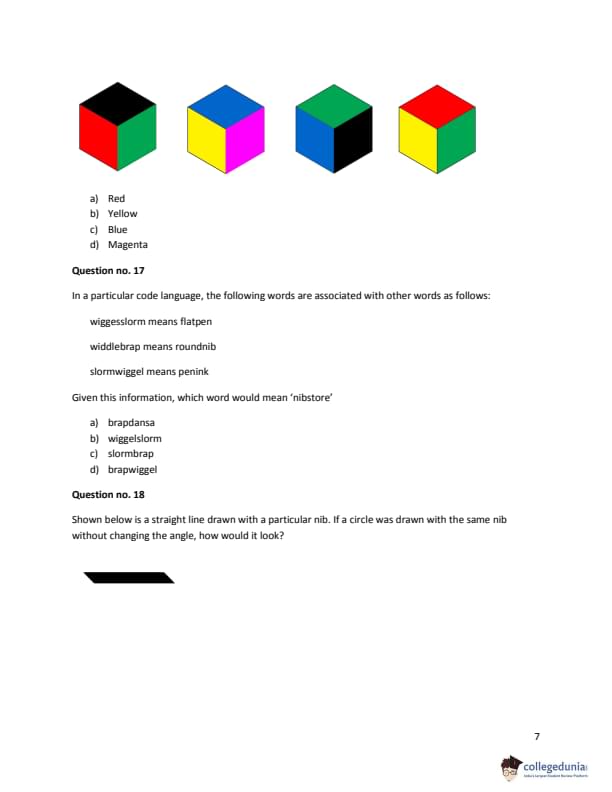
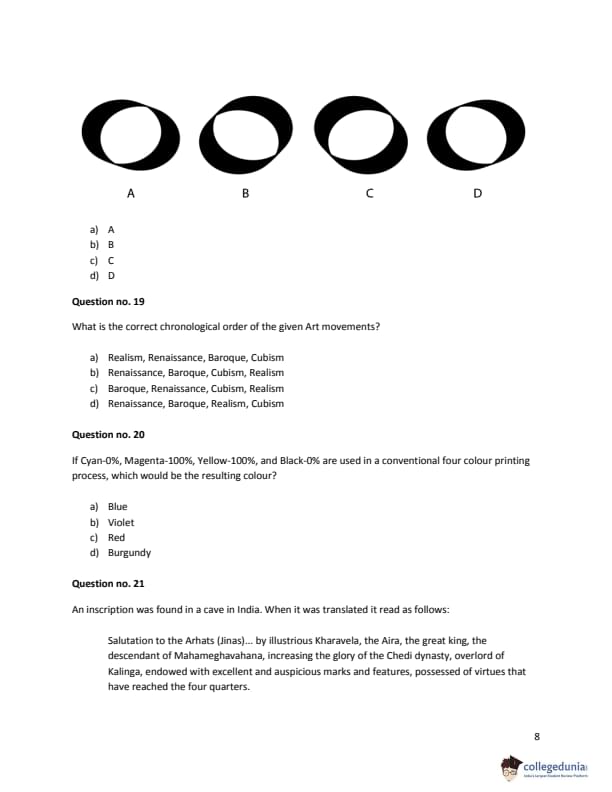
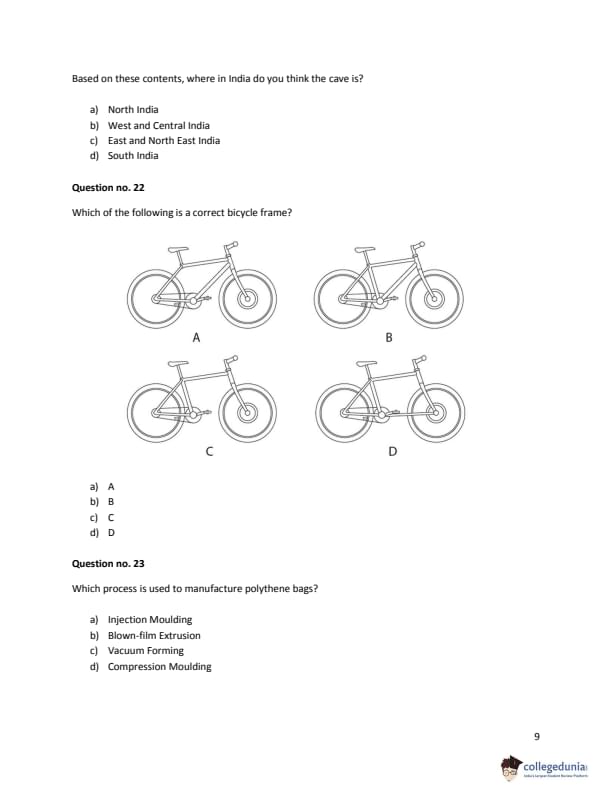
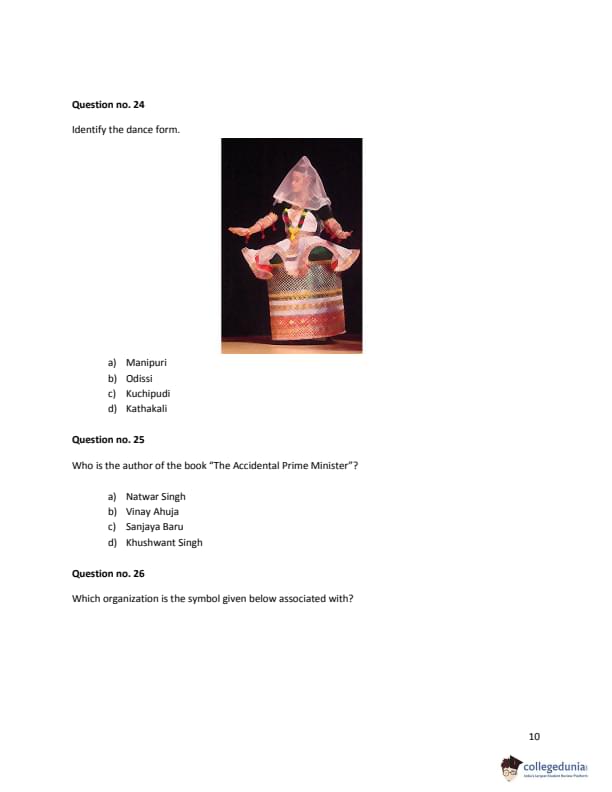
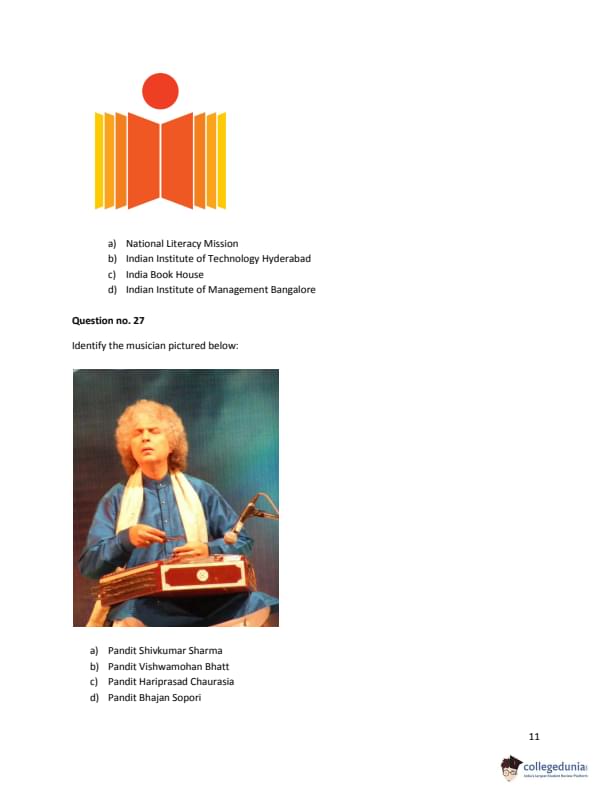
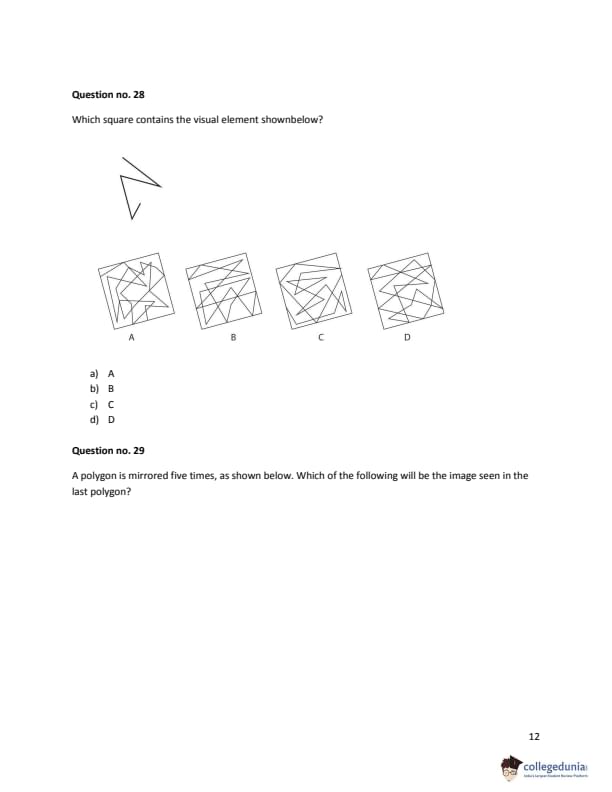
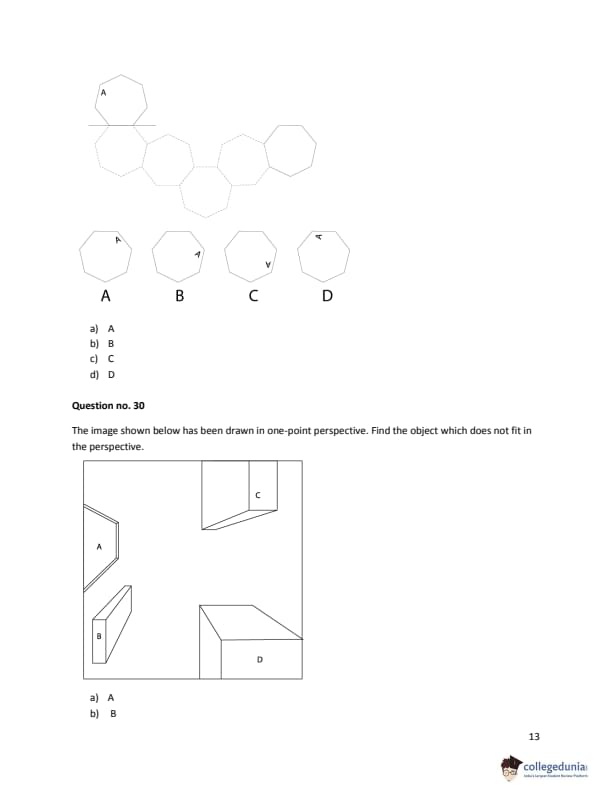
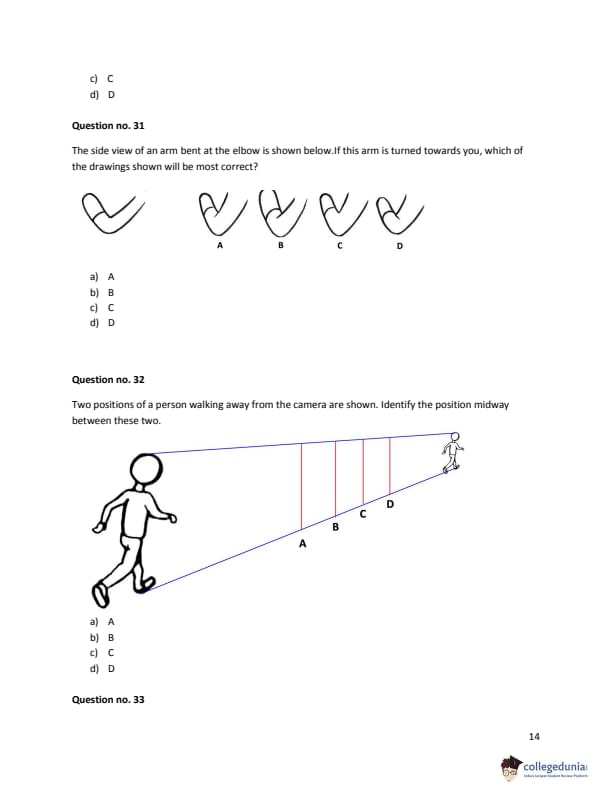
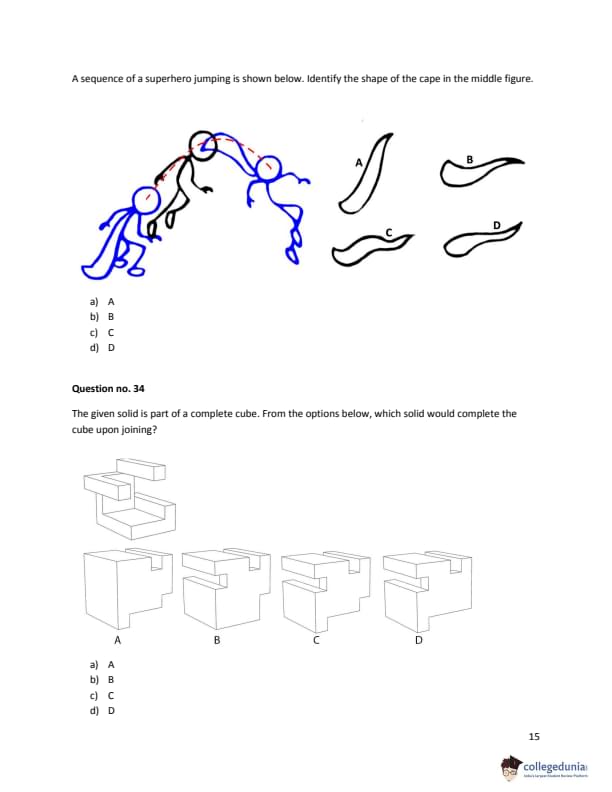




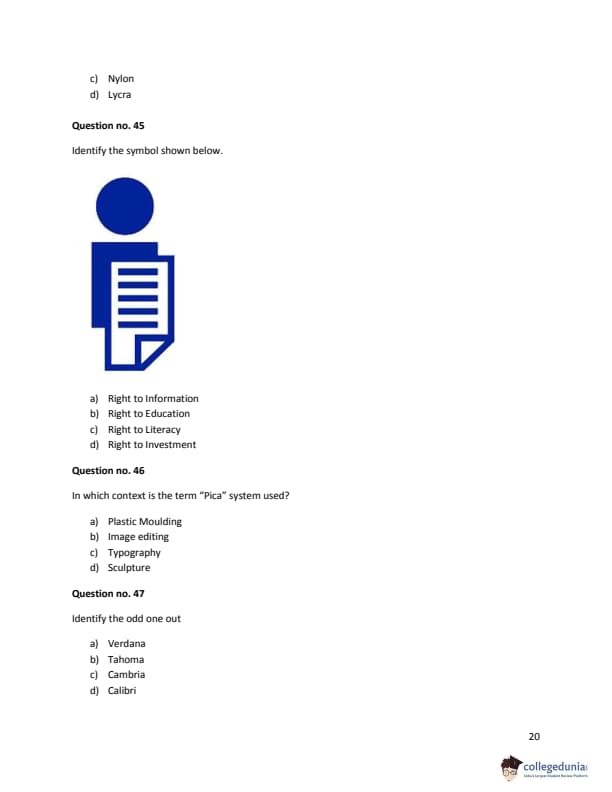
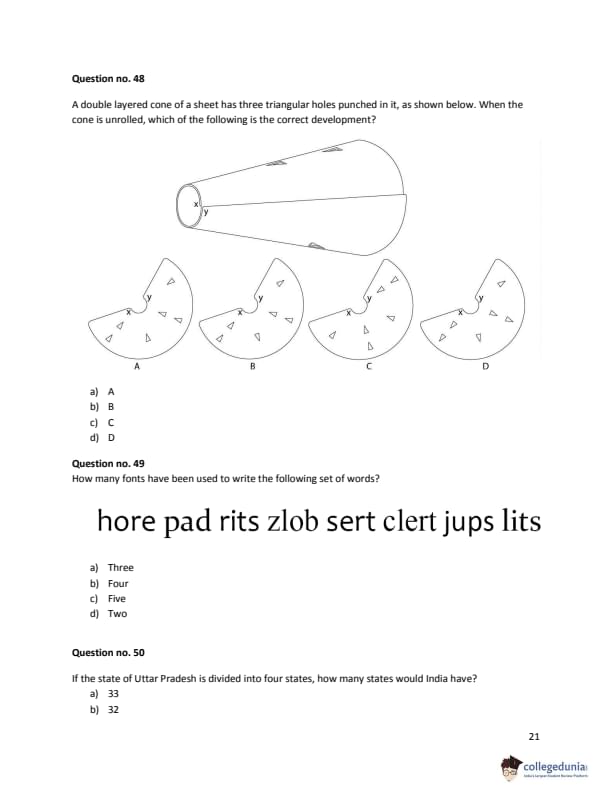
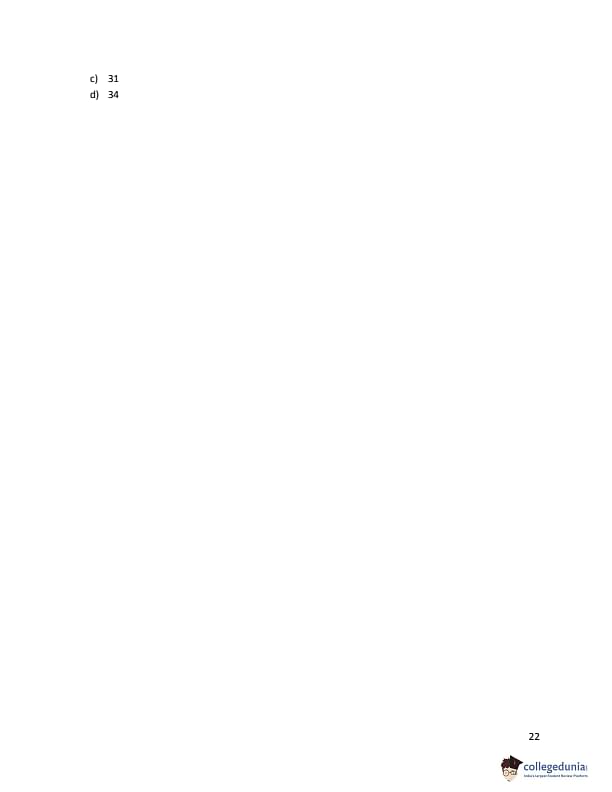
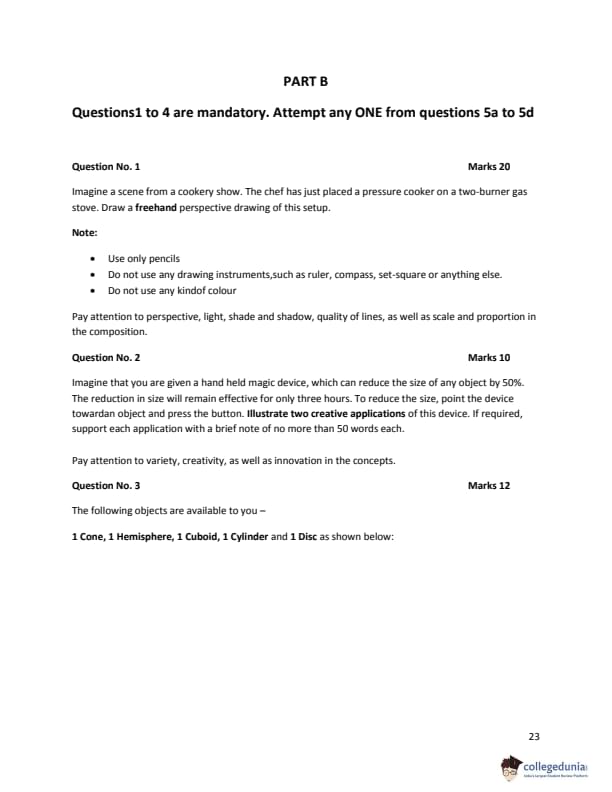

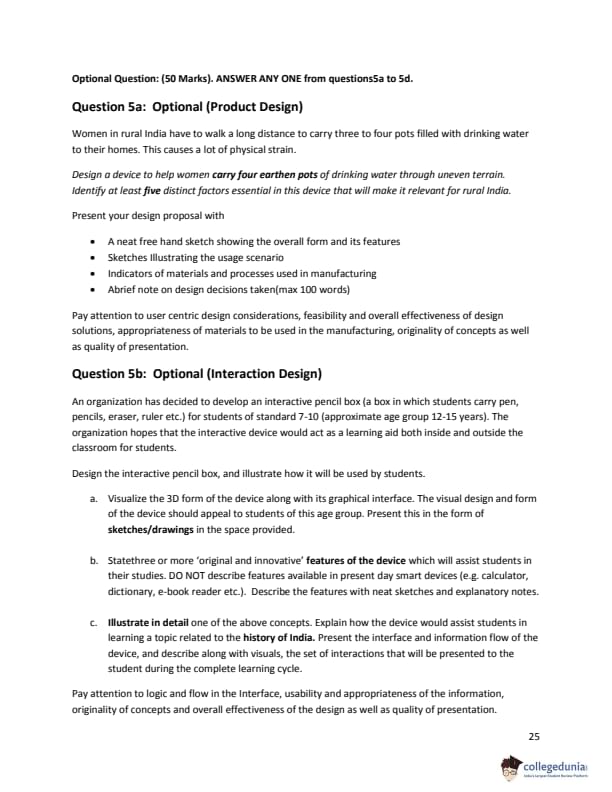
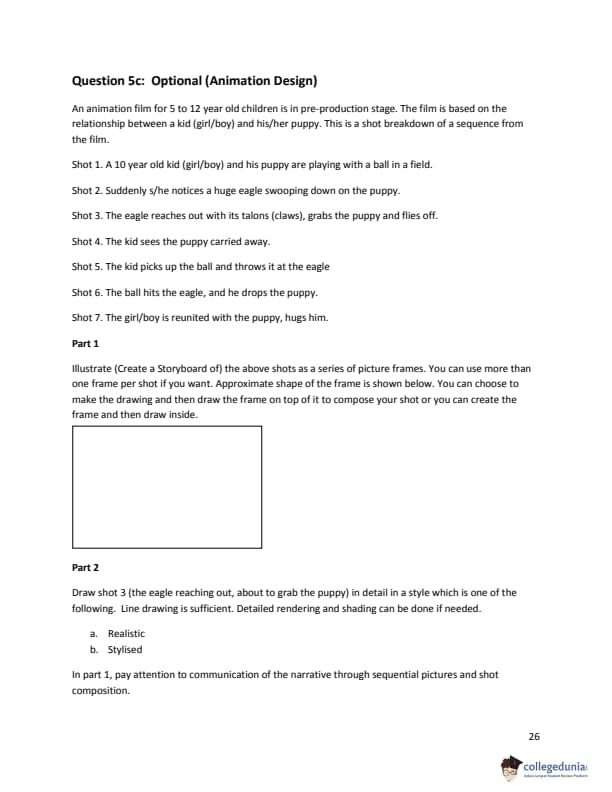
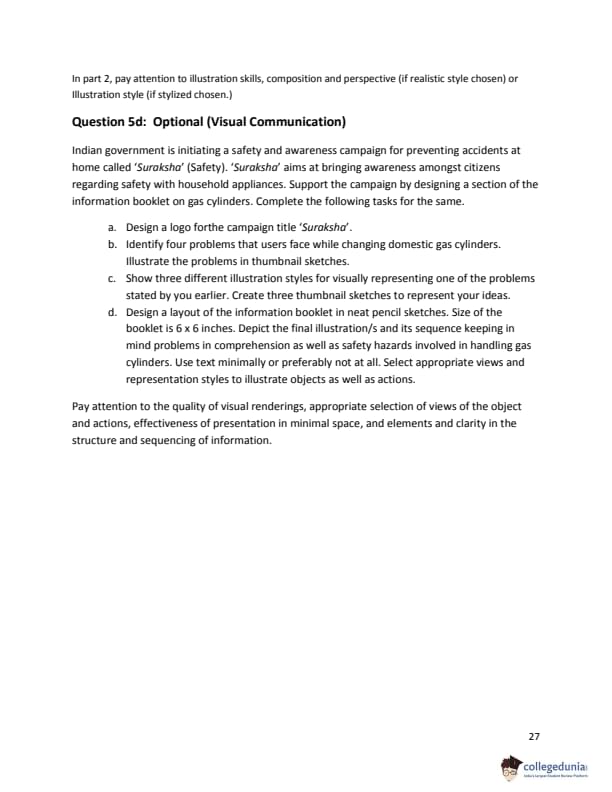

Comments